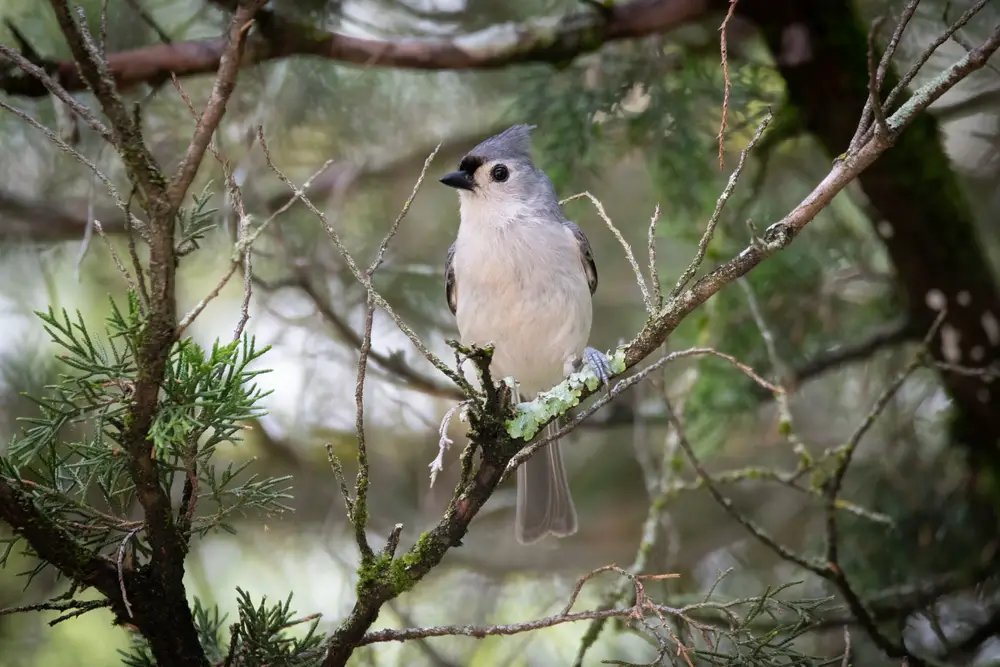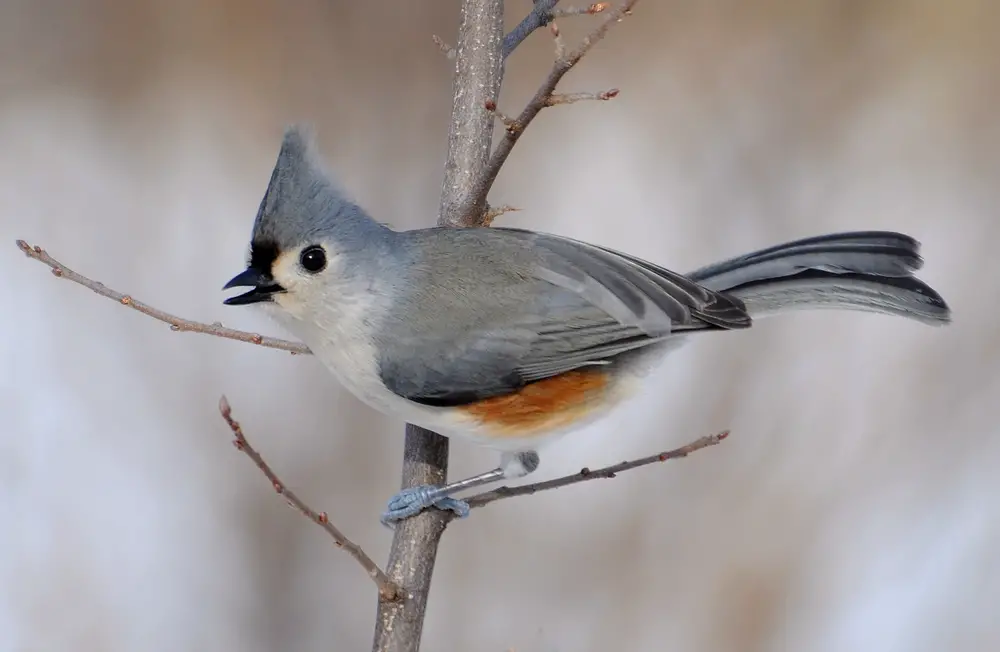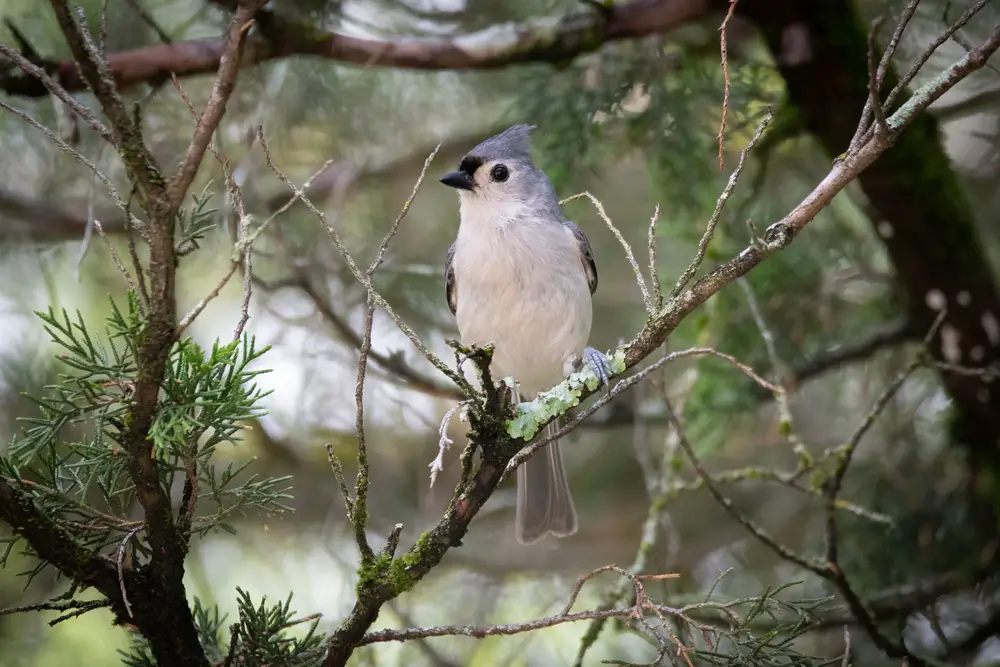The Tufted Titmouse (Baeolophus bicolor) is a small grey-brown bird found in forests and woodlands across the eastern United States. It is easily identified by its black head, white face patch and distinctive crest atop its head.
This species has adapted to human presence and is often seen at backyard feeders or hiking trails. Despite its diminutive size, the Tufted Titmouse plays an important role in maintaining healthy ecosystems that not only benefit other animals but also humans who enjoy these wild places.
This article will explore how the Tufted Titmouse interacts with its environment and how this species contributes to healthy habitats for itself as well as other plants and animals. The physical characteristics of the bird, its range and habitat preferences, diet, behavior patterns, mating habits, nesting sites and conservation status will be discussed.

Overview
The Tufted Titmouse (Baeolophus bicolor) is a small songbird found throughout North America. It is a common bird in backyards and parks, often seen at bird feeders. This species of titmouse has distinctive tufts on the crowns of its head that give it its name. Its plumage varies depending on geographic location, but overall is grayish-brown with an underbelly ranging from white to rusty orange. The bill is black and stout, while the feet are greyish-white.
Though primarily insectivorous, the Tufted Titmouse will also consume nuts and fruits when available. Their diet consists mostly of beetles, caterpillars, spiders and other insects as well as some seeds and berries during winter months. In summer they can be observed foraging through foliage searching for food or perched atop branches singing their songs; both activities make them excellent subjects for birdwatching enthusiasts.
When threatened by predators such as hawks or cats, the Tufted Titmouse will gather together in large numbers to mob them until they leave the area. They are active year round so they rarely form flocks but may join mixed species flocks during migration periods or when food sources become scarce.
Habitat And Range
The Tufted Titmouse has a wide geographic range in North America. It is found from southern Canada, south to the Gulf of Mexico and east from western Texas all the way to coastal New England. Its habitat consists mainly of deciduous woodlands, but it can also be found in residential areas with large trees and bird feeders.
The species’ range expansion has been attributed to its adaptability to urbanization, which has allowed them to move into more densely developed areas than other birds their size. They have experienced recent range contraction due to severe storms occurring along the East Coast and extreme winter weather at northern latitudes. Despite this setback, they are still relatively common across much of their range and remain one of the most abundant birds in many parts of their native habitats.
It is important that we protect existing habitat for the tufted titmouse, as well as ensure proper stewardship practices through thoughtful land management decisions so that populations may continue thriving across their broad geographic range.
Breeding Habits
The tufted titmouse is a songbird that displays various types of courtship behaviors to attract a mate. During the breeding season, these birds will sing and perform aerial acrobatics together in pairs. The male also performs an elaborate display for the female which involves fluffing up its feathers before bowing with wings spread out and tail pointing downward.
During nesting season, both parents work together to build their nest using plant material such as twigs, grasses, rootlets and moss. They construct it in an upright cup-like shape inside tree cavities or birdhouses and line it with soft materials like animal fur or wool. It typically takes 3–7 days for them to complete construction.
Once constructed, the female lays 4–5 eggs with white to yellowish coloration speckled with brown spots on one side. She alone incubates her clutch while the male feeds her throughout this period of 12–14 days until they hatch. Once hatched, both parents feed their young ones by regurgitating food into their mouths every minute or so over a course of 16–18 days before fledging occurs where they learn how to fly independent of their parents’ care.
Diet And Foraging Behavior
The Tufted Titmouse is a seed-eating bird, though it does consume some insects. Its foraging behavior includes gleaning from trees, shrubs and vegetation, as well as searching through leaf litter on the ground. It also visits bird feeders to obtain food sources.
The species’ diet preferences vary seasonally with greater consumption of insects during warmer months when they are more abundant. Additionally, this species will migrate in order to take advantage of different food sources throughout the year.
Insects form an important component of the Tufted Titmouse’s diet; these include spiders, caterpillars and beetles among others. Seeds such as sunflower seeds, millet and cracked corn can be found at backyard bird feeders which are readily taken by this species. Other food items include grains, berries, nuts and other fruits depending on what is available.
These birds also eat acorns which are stored away in large numbers for later retrieval or caching them in bark crevices or holes in trees to preserve them until winter arrives when both insect availability and temperature decreases substantially.
The Tufted Titmouse has adapted its foraging habits due to urbanization over recent decades; now visiting human-made structures such as residential gardens for supplemental meals alongside natural habitats like forests where they can find their usual array of food sources throughout the day.
This species is considered very adaptable because of its ability to change dietary needs according to seasonal shifts while making use of various resources provided by humans living nearby.
Adaptations
The tufted titmouse is a species of small songbird that has adapted to its environment in multiple ways. Its camouflage adaptations are primarily used for protection from predators and include grey or brown feathers on the upper body and bright white undersides, which helps it blend into its forest habitat.
This bird migrates south during the winter months when food sources become scarce in order to survive the cold season. It also uses vocalizations as a form of communication with other birds, including warnings of danger or mating calls.
Its weather adaptations help it live through extreme temperatures by huddling together with others in flock-like formations to keep warm while roosting at night. This behaviour ensures their survival throughout any harsh climates they may encounter.
As demonstrated, there are numerous adaptive behaviours employed by the tufted titmouse to thrive within its environment. From protective colouration against predators to vocal communications amongst one another, these birds have developed strategies for success in many areas of life.
Furthermore, their migration habits and huddling tactics enable them to adapt quickly to changing conditions such as temperature fluctuations or food shortages without issue. Thus, the tufted titmouse is well equipped for surviving many different scenarios due to their impressive array of natural abilities and instinctual responses.
Conservation Status
The tufted titmouse has become an increasingly popular backyard species in the United States, and its adaptability to human-altered landscapes may mask the fact that it is facing some challenges. This mid-sized songbird’s conservation status is of concern due to a variety of threats, most notably habitat loss and climate change.
Habitat loss continues to be one of the greatest threats faced by many bird species throughout North America, including the tufted titmouse. As more natural habitats are replaced with housing developments and agricultural land, the number of suitable nesting sites for this species declines dramatically.
In addition, climate change continues to alter migratory patterns and breeding habits; these changes can make it difficult for birds such as the tufted titmouse to find food sources or suitable nesting spots during their migration or breeding season.
In response to these threats, conservation efforts have been put into place in order to protect populations of wild tufted titmice from further decline. Organizations like Audubon have worked tirelessly to create sanctuaries where these birds can live safely away from development and climate impacts. In addition, education initiatives have helped spread awareness about how humans can help preserve natural habitats so they remain available for future generations of wildlife.
With continued advocacy and protection, there is hope that populations of the tufted titmouse will continue to thrive across its range despite ongoing environmental pressures.
Interesting Facts
The tufted titmouse (Baeolophus bicolor) is a small passerine bird that can be found in North America. It is easily identified by its distinct gray and white feather coloration, with a prominent crest atop its head. The adults measure approximately six inches long, with a short but stout beak of black-brown hue.
In addition to its distinctive visual appearance, the tufted titmouse also has several unique vocalization habits. Its typical call consists of low “peter” notes followed by higher pitched trills as it forages for food or interacts with other birds. In addition, males will often sing an exuberant song consisting of two phrases: “fee-bee” and “tee-dee.”
Migration timing varies among titmice populations; some migrate south during winter while others remain year round across their range from east Texas up through southern Canada and New England. Regardless of migration pattern, young tufted titmice typically build cup nests using mosses, grasses and bark strips held together with spider webs or mud.
This species provides many benefits to nature enthusiasts alike due to its vibrant plumage and melodious calls. Furthermore, they are important insect controllers which makes them beneficial to local agricultural activities such as fruit tree pollination and pest control.

Conclusion
The tufted titmouse is a small bird native to North America. This species of bird is known for its large and distinctive head crest, which gives it its name. It is an adaptable species found in a variety of habitats throughout the United States and Canada, from woodlands and forest edges to suburban parks and gardens.
Tufted titmice breed mainly during the spring months when males court females with song and display flights. They feed on both insects and seeds, using their sharp bills to crack open seeds or search bark crevices for insect larvae.
The tufted titmouse has several adaptations that help it survive in its environment such as strong wings for long distance flight, cryptic plumage to camouflage itself against predators, and vocalizations used for communication within flocks. Currently this species is not considered threatened; however conservation efforts are needed in order to ensure future populations remain healthy.
In conclusion, the tufted titmouse demonstrates many fascinating behaviors and characteristics that make it an interesting subject of study. Its ability to thrive across different habitats makes it one of the most common birds encountered by humans living in North America today.
With threats facing other avian species due to habitat destruction, understanding the biology of this resilient species can be used as a model for conserving lesser-known birds around the world. Further research into how these birds interact with their environment will provide valuable insight into how we can better protect our feathered friends now and in the future.

